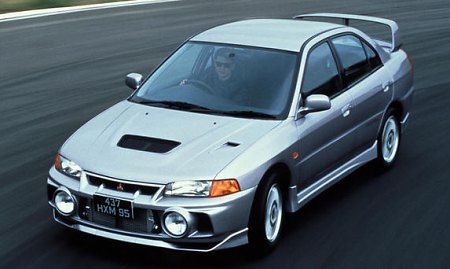 In my opinion, Group A WRC
was the greatest ever invention by motorsport governing body FISA
(later became FIA). To qualify for the category, manufacturers had to
build at least 5000 road cars in similar specifications to the race
cars. This created many of the world's best ever A-to-B road cars, for
example, Lancia Delta Integrale, Ford Escort RS Cosworth, Toyota Celica
GT4, Mitsubishi Lancer Evolution series and Subaru Impreza WRX series.
Unlike the Group B cars preceding them, these cars were really road
cars that you could enjoy driving every day, with perfectly acceptable
comfort, build quality and practicality. That's why car lovers miss the
Group A-era so much! I really wish WRC could revert to Group A spec.!
The early Lancer Evo was not as appealing as the established Lancia, Ford or Toyota, but Mitsubishi committed to its long-term development, introducing a new version every 18 months or so. By the late-1990s it became the most fearsome A-to-B road car on the planet. Eventually, 10 generations were launched in 20 years' time, making it the most popular road-going rally car ever. Over the years, the Evo grew in size and gained sophistication gradually. Sometimes it took a larger step as it switched to a new generation Lancer platform – Evo I to III were derived from the 5th generation Lancer, Evo IV to VI from the 6th generation, Evo VII to IX from the 7th generation and Evo X was built on the 8th generation. Despite this, all bar the last one employed the evergreen 4G63 2.0 turbo engine whose history could be traced back to Lancer EX2000 Turbo in 1981. Due to the increased weight and the limitation to 2-liter capacity, its performance had been largely flat-out since Evo V, thus subsequent improvement was concentrated on handling and drivability. The evolution of Evolution
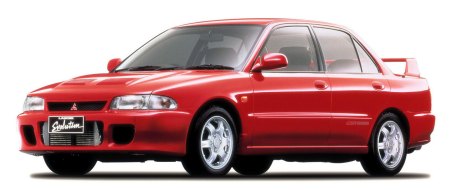 The earliest Lancer
Evolution was launched in Oct 1992 as a limited production run of 5000
cars. Taking over Galant VR-4 as the company's rally car, it got that
car's 4-wheel drive system with viscous-coupling center differential
and 4G63 turbocharged 16-valve engine but
enclosed in a smaller and lighter package. The engine was improved to
produce even more power at 250 hp. In addition to an aluminum bonnet,
close-ratio gearbox, uprated brakes, Recaro bucket seats and Momo
steering wheel, the first generation was already a spectacular
cannonball. Externally, it can be distinguished from the regular Lancer
by its extra aero kit, a pronounced bonnet and larger air intakes.
Compare with the contemporary Lancia Delta Integrale Evo, the Mitsubishi was 110 kilograms lighter yet boosted 40 more horsepower. It was believed to be capable of sprinting from 0-60 mph in just over 5 seconds, which was nearly supercar performance in those days! What a pity its sales was restricted to Japan. 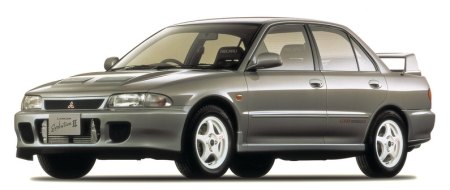 Evo II was launched in Jan
1994. Its production was again limited to 5000 cars. While it didn't
look markedly different from the original, it adopted a number of
modifications: the engine was tuned to 260 hp without affecting torque
delivery; the chassis was stiffened by 30 percent; the suspensions were
retuned to improve handling; wider tires and larger 16-inch wheels were
adopted to enhance grip; an extra lip spoiler was added below the front
bumper to improve aerodynamics. Besides, the viscous-coupling rear LSD
on the old car was replaced with a mechanical type. Thanks to the
improved handling, the Evo II finally brought Mitsubishi the first WRC
victory in the 1995 Swedish rally.
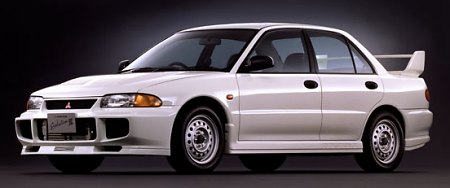 Evo III arrived in Feb
1995. Its engine was boosted to 270 hp at slightly higher rev, thanks
to a new turbine, higher compression ratio and reduced exhaust back
pressure. Moreover, its intercooler got water spray to keep high output
lasting longer. Outside, its aerodynamic kits were overhauled, with
deeper air dam and skirts and larger rear spoiler to cut aerodynamic
lift, enlarged intakes to feed the radiators and brake ducts. These
changes were proved effective in motor racing. The Evo III rally car
took 5 WRC victories in 1996, bringing Tommi Makinen and Mitsubishi
their first driver's title. More would come in the next few years...
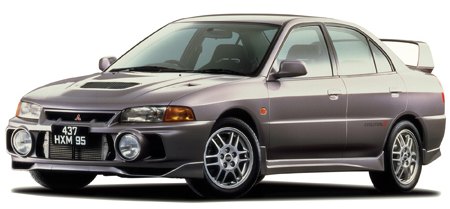 Evo IV from Aug 1996 was
based on the body of new generation Lancer. Apart from the stronger
chassis, a lot effort was made to the engine and drivetrain. Racing
camshaft, lighter pistons, improved induction and exhaust yielded
another 10 hp and more important, 33 lbft of torque. A twin-scroll
turbo reduced exhaust interferences, improving low-end response and
cutting turbo lag. 0-60 mph now dropped to 4.8 seconds. Larger brakes
were adopted to match the increased performance. AYC Active Yaw Control
made its debut on the Evo IV. It was actually an active rear
differential, helping the car to regulate understeer and oversteer.
Externally, this car looked almost a rally car with its monstrous-size
intakes and large fog lamps, but people liked it! 9,000 cars were built
and all sold quickly.
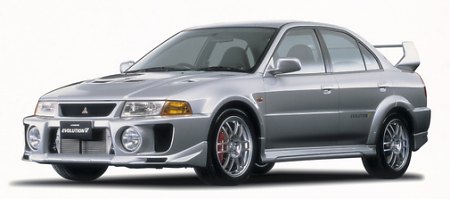 Debuted in Jan 1998, the
Evo V was another big improvement. Its flared wheel arches accommodated
wider tracks (up 40 and 35 mm front and rear, respectively) and larger
17-inch wheels shod with wider 225/45 tires. The suspension received
optimized geometry, lightweight aluminum control arms and inverted
dampers that lifted chassis rigidity. New brakes incorporated
high-performance Brembo calipers. The AYC was further refined to reduce
the understeer found on the previous generation. The new rear wing got
an adjustable foil to alter downforce setting. All these significantly
improved its handling.
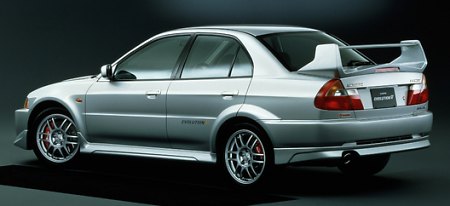 Meanwhile, the engine got a new turbocharger and improved intercooler, lifting maximum torque from 261 to 275 lbft. While peak power was still quoted at 280 hp, or the upper limit agreed by Japanese manufacturers, the actual figure was undoubtedly higher. Road test found the Evo V was capable of 0-60 and 0-100 mph in 4.7 and 12.3 seconds, respectively. That put it ahead of many expensive performance cars of the day, including BMW M3 E36, Skyline GT-R R33, Mitsubishi's own flagship GTO and even Honda NSX. When the road got rougher and twistier, the Evo was even probably the fastest car in the world. Only the contemporary Subaru Impreza WRX STi Version IV could rival it. 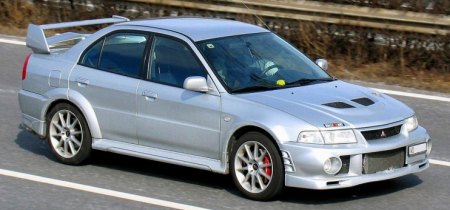 Janurary 1999 came Evo VI.
In this generation the improvement concentrated on aerodynamics as a
response to the changes made to WRC regulations. In particular, the
rear wing became bi-plane. Engine cooling was also enhanced, making the
same power and torque more durable. RS model introduced the world's
first titanium turbine to reduce turbo lag. Besides, the chassis got
extra spot welds to increase rigidity while the suspension got some
detailed modifications. The Evo VI was probably no faster than its
predecessor, but it was undoubtedly more competitive in rally stages.
It brought Makinen the fourth consecutive WRC driver's title, also the
last time for the Mitsubishi rally team. Since the championship shifted
from Group A production cars to more specialized WRC-spec machines, the
Lancer Evolution series had lost its advantage.
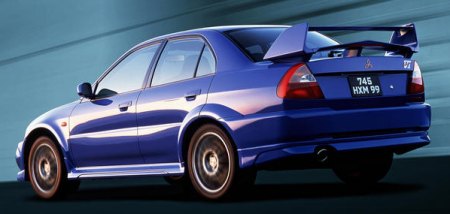 While all previous Evos were bounded in Japan, a small batch of Evo VI was officially exported to the UK. When Autocar road tested it in 1999, it recorded some very exciting performance figures: 0-60 in 4.4 sec and 0-100 in 11.2 sec. It praised the car for not only lightning speed but also first-rate braking, immense traction and grip and eye-widening handling. It described the car "feels more like a fighter aircraft than it does a humble automobile in the way it slices into bends, and then sucks itself to the floor, seeming to defy the laws of physics as it goes". The only complaints were the stiff low-speed ride and a steering that was not as feelsome as a focused driver's car should. As for conclusion, the magazine said "This is a car which can swallow four adults and their luggage as effectively as any Ford Mondeo, yet one which can level with all but the fastest Ferraris in a straight line. A car that's as refined as a Nissan Primera on the motorway yet one that can out-corner and out-brake any product currently made by Lotus. Yet it's also a car that costs no more than a well specified, non M-badged BMW 3-series." As the Evo VI was lighter and actually faster than the subsequent Evos, it was widely regarded as the best of the breed. 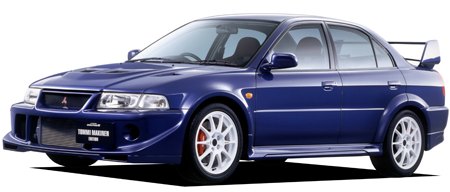 Evo VI Tommi Makinen edition Jan 2000 introduced Tommi Makinen edition of Evo VI as a
celebration to the driver's 4th consecutive WRC title with Mitsubishi.
Cosmetic changes aside, there were some minor tweaks – the ride height
was dropped 10mm (hence an even harsher ride), revised titanium turbine
to improve low-end response, more engine cooling, larger-diameter
exhaust and improved oil pan. A new air dam improved aerodynamics and
engine cooling. The Makinen edition was usually referred to Evo 6.5.
Hardcore drivers saw it as the best of the best.
 The Evo VII that arrived in Feb
2001 switched to the new generation Lancer Cedia platform, whose
wheelbase grew by 115 mm to 2625 mm, actually longer than the original
Galant VR-4! It was also considerably longer and taller than the old
car. Even with extensive weight reduction, the car still carried 40 kg
more than before. On the positive side, the new body shell with extra
spot welds displayed 50 percent higher torsional rigidity. Wider front
track and more suspension travel benefited handling. The 4G63 engine
received minor modifications like hollow camshafts, smaller turbine
nozzle (to improve response), higher flow intercooler with water spray,
a larger oil cooler and a variable back-pressure exhaust. It generated
7 more lbft of torque while officially the max power was still claimed
at 280 hp. However, the most important change must be the 4WD system -
now with electronic-controlled active center differential (ACD) in
combination with AYC. Handling was much improved as a result. The Evo
VII was slower than Evo VI in straight line, but it should be
marginally quicker in the twisty.
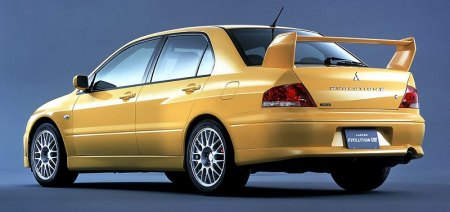 A year later, the Evo VII was joined with a more civilized
version called GT-A. It got an engine detuned to 272 hp and 253 lbft,
5-speed Invecs-II semi-automatic gearbox, milder aero kits, more
luxurious interior and softer suspension in order to attract less
hardcore drivers. Mitsubishi now needed more sales to justify for its
development costs.
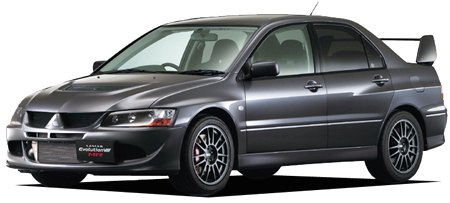 As the rally campaign had
switched to WRC-spec machines which had less relevance to the road car,
Mitsubishi could slower the pace of the Evo's development. Generation VIII arrived 2 years
after the VII in Jan 2003, yet it was not a major upgrade. Style-wise,
it could be easily distinguished from the old car by a new corporate
grille and an extended front overhang which reserved space for an
anti-intrusion bar required by US regulations. Extra ventilation holes
were opened on the front bumper to feed the larger intercooler. In
addition to modified exhaust and a more efficient turbocharger, the
long-serving 4G63 motor produced another 7 lbft of torque at 289 lbft.
Horsepower remained at 280, but most believed the actual figure should
be 310. The big news was a new 6-speed close-ratio manual gearbox,
which helped the new car to recoup the performance lost in Evo VII. The
AYC active yaw control was upgraded to Super AYC, using planetary gear
instead of bevel gears to double the amount of torque transfer allowed
between rear wheels. As a result, the Evo VIII cornered even quicker
than Evo VII. It steering became even shaper, without understeer even
approaching its cornering limit.
The cash-strapped Mitsubishi now wanted even more return on investment on the Evolution series. On the one hand, the Evo IX was no longer a limited production. Mitsubishi would supply as many as demand. On the other hand, it introduced a cheaper version called simply "Lancer Evolution" to the USA market. This car was 70 kg heavier due to the addition of anti-intrusion bar added to the nose. Emission regs dragged down its power to 271 hp, so it was slower than the Japanese version. Moreover, its ACD and AYC were replaced by a viscous coupling and a mechanical LSD respectively in order to save costs. More than 10,000 cars were sold in the United States. Feb 2004 saw the release of Evo VIII MR, whose name meant "Minor Revision" – no, actually "Mitsubishi Racing". Its turbocharging system was tuned to deliver stronger high-rev output (though still quoted 280 hp) and a little more torque again. Some weight saving measures cut 10 kilos from the kerb weight. In particular, the roof was made in aluminum to lower center of gravity. Bilstein dampers improved ride a little. The ACD and AYC were reprogrammed to intrude less with ABS. Exterior remained unchanged though.  Another 2 years had passed
and the 9th generation
debuted in March 2005. This was also the last one built on the
contemporary Lancer platform and with the legendary 4G63 engine. The
latter gained MIVEC intake variable valve timing and, accompanied with
yet another fine tuning of the turbochargying system, produced slightly
more torque and a flatter torque curve. Like the previous MR, the roof
was made of aluminum – this made the new MR model less significant. The
rear spoiler was made of hollow carbon-fiber. Cosmetically, it
abandoned the previous corporate grille and returned to a no-nonsense
one. Aerodynamics was barely revised. The Evo IX was the least improved
generation of all.
 When Evo X was launched in
October 2007, it caused a lot of controversies. For the first time in
the history of Evolution, this car was completely renewed, so new that
many didn't see it as the same breed. It was built on the new Lancer /
Galant Fortis platform which was considerably larger, and 130 kg
heavier than Evo IX, resulting in a power-to-weight ratio actually
lower than that of the first generation Evo. This hampered its straight
line performance as
well as agility on narrow mountain roads. The all-new 4B11 motor
remained 2 liters, but it had an aluminum block and modern dual-VVT to
boost maximum torque to 311 lbft. Horsepower was initially quoted as
280 hp (JIS) or 295 hp (SAE), but a year later the Japanese rating was
lifted to 300 hp as Mitsubishi followed Subaru to abandon the voluntary
limit. Equally new was the 6-speed SST twin-clutch gearbox, which
helped recoup some performance lost to the increased weight.
On the road, the Evo X had a smoother ride thanks to its stiffer chassis, longer wheelbase and modern NVH suppression. Its handling and steering were less influenced by road irregularities and bumps. Although it wasn't as explosive or as communicative as the old car, its S-AWC (Super All-Wheel Control) system, which integrated ACD, AYC, ABS and stability control, resulted in better handling. However, the magic of Evo had been losing since Mitsubishi withdrew from world rally championship after 2005. Without the intense competition of motorsport, the road car lost focus. It became prone to commercial considerations and far removed from its original philosophy. Group A rallying created the best generations of road cars. The demise of Group A signaled the end of a great era, even though the Lancer Evolution series sustained that flame longer than everyone else. |